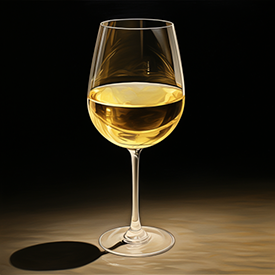The Crucial Role of Sulfites in Winemaking from Fresh Grapes
Posted by Matteo Lahm on 29th Oct 2025
You might have been making wine from grapes and fresh juices for years. You might even be a multigenerational winemaker. Maybe you have sworn off sulfiting your must before pitching your yeast under the assumption that if your dad didn’t do it, why should you? If this describes you, now ask yourself if you have lost some batches over the years or had less than stellar results? If the answer is yes, you might want to continue reading. The bottom line is that you might be overlooking the cheapest and most effective insurance policy money can buy for your wine.
You cannot see it, but your grape must is the scene of an epic Homeric battle. It's a clash of the titans, a microbial melee, where wild and commercial yeasts vie for dominance. This competition can significantly impact your wine’s flavor and quality, making the use of sulfites the ultimate fortress for your grapes before pitching your yeast.
Let's delve into the nitty-gritty of how sulfites work their magic in the winemaking process. Sulfites, or sulfur dioxide, have been unfairly labeled as the 'bad boys' of the wine world. However, they are, in fact, guardians that ensure the integrity of your wine. The fact is that there is so much that can go wrong, avoiding sulfite usage before inoculating your must means risking hundreds or even thousands of dollars. It could cost you your entire batch. Not convinced? Read on!
Even on the vine, your grapes are covered with countless saboteurs just waiting to have an unsanctioned party in your fermenter. If that were not enough, if you are buying your grapes from a retailer and those grapes have been shipped, then you have the added problem of perilously unnatural conditions that just add insult to injury. Sulfites can solve almost all of these problems. While they are the nuclear option with wild yeasts and bacteria, not only will they not inhibit your commercial yeast, they will ensure its optimum performance. Let’s dive in further.
When added to grape must, sulfites act as a potent antimicrobial agent. They work by releasing sulfur dioxide gas, which is toxic to most yeasts and bacteria. This gas permeates the must, effectively killing off the majority of wild yeasts and bacteria present. It's like a microscopic disinfectant, cleaning the grape must of unwanted microbial guests.
But why doesn't this sulfur dioxide gas kill off the commercial yeast? The answer lies in the resilience of these specially chosen yeasts. Commercial yeasts are selected for their ability to withstand higher levels of sulfur dioxide. They have evolved mechanisms to detoxify the sulfur dioxide, allowing them to survive in its presence.
This resilience is a product of careful selection and breeding by yeast manufacturers. They cultivate these yeasts under conditions that mimic the harsh environment of a sulfite-treated grape must. Over time, the yeasts that survive are those that can withstand high levels of sulfur dioxide. These resilient yeasts are then harvested and sold to winemakers.

So, when sulfites are added to the grape must, they create an environment where only the hardiest yeasts - the commercial yeasts - can survive. This allows these yeasts, chosen for their desirable fermentation characteristics, to ferment the grape juice without competition from wild yeasts or bacteria. With winemaking, yeast competition is bad, very bad. You want your yeast to have an open highway with no disruptions. Not sulfiting your must is like letting your yeast go a hundred miles an hour on a road with big potholes.
In essence, the use of sulfites in winemaking is a strategic move. It's a way of leveling the playing field, ensuring that the commercial yeast can do its job without interference from unwanted microbial competitors. This results in a controlled fermentation process, leading to a high-quality, consistent wine.
Without the use of sulfites, the wild yeast naturally present on the grape skins, known as Saccharomyces cerevisiae, can compete with the commercial yeast strains introduced during the winemaking process. This competition isn't just a simple race to consume sugar; it's a complex biochemical battle that can significantly alter the fermentation process.
In the absence of sulfites, the wild yeast can begin to metabolize the sugar in the grape must almost immediately. That gives them a head start against your cultured yeast. If you get an aggressive strain, their populations can get high enough to make it harder for your cultured yeast to take off. While it struggles, these wild yeasts can produce a variety of secondary metabolites, including acetic acid, lactic acid, and other organic compounds that can contribute to off-flavors in the wine. Some are subtle and others horrendous. When the competition gets really tense, the yeast produces hydrogen sulfide gas. Imagine a crate of rotten eggs in your workshop but the stench will not be the eggs, it will be your wine.
Moreover, if the wild yeast strains win out, they are often less tolerant of the high-alcohol environment created during fermentation. As a result, they may die off before all the sugar is consumed, leaving residual sugar that can make the wine overly sweet or, worse, restart fermentation after bottling, leading to fizzy wine or even exploding bottles.
On the other hand, commercial yeast strains have been selectively bred for their ability to efficiently convert sugar to alcohol, their tolerance of high-alcohol environments, and their production of desirable flavor and aroma compounds. By using sulfites to eliminate the wild yeast, winemakers can ensure that the commercial yeast can do its job unhindered, leading to a more predictable and controlled fermentation process.
In essence, without sulfites, the fermentation process is like a sophisticated party where a rowdy, unpredictable crowd has been invited. The wild yeast, with their unpredictable behavior and inefficient metabolism, can cause a ruckus, leading to a final product that's far from the desired outcome.
If the threat from wild grape yeasts were not enough, now let’s venture into what happens when they leave the vineyard. Grape shipment is the post-apocalyptic microbial world that grapes encounter during transit. These grapes, much like globe-trotting tourists, are exposed to a plethora of alien environments, each teeming with its unique microbial population.

One such environment is the refrigerated trailers used for transporting food. These trailers, often used for carrying a variety of items, can harbor a diverse range of microbes. For instance, wild grain yeast, a common inhabitant of such trailers, can potentially hitch a ride on our grape tourists. This yeast, known for its robustness, can ferment at a variety of temperatures and produce a range of flavors. If it manages to infiltrate the grape must, it could outcompete the commercial yeast, leading to a completely different flavor profile in the wine.
Similarly, cultures found on cheeses, such as Penicillium roqueforti or Brevibacterium linens, could also find their way onto the grapes. These microbes, while essential for cheese-making, can wreak havoc in winemaking. They can alter the fermentation process, leading to off-flavors and spoilage.
Moreover, these trailers can also harbor bacteria like Lactobacillus and Pediococcus. While these bacteria are often used in beer and cider production to add complexity and tartness, in winemaking, they can cause malolactic fermentation. This secondary fermentation can drastically change the wine's acidity and flavor, often resulting in a buttery taste and aroma. In some wines, this is actually very desirable however in others, not so much. Even if you get lucky, the greater point is that you cannot control who handles your grapes and how. You cannot account for what you cannot control.
In essence, the journey of grapes from vineyard to winery is fraught with potential microbial encounters. If a dominant strain from these alien environments manages to infiltrate the grape must, it can take over the fermentation process, leading to unexpected and often undesirable results. Therefore, treating the grape must with sulfites before pitching yeast is crucial to ensure a controlled fermentation process and a high-quality wine.
Now if you are working from fresh juice, you not only have the wild strains from the actual grapes, you might even have residual cross contamination of strains from other grape varietals that were previously processed. Juice is an agricultural product which is subject to different rules and regulations. The bottom line is that the more competition between potential dominant yeast strains, the more that can go wrong in your batch. You would not plan a garden without first clearing the weeds. Apply the same principle to your wine yeast.
Think of it as a road trip. You wouldn't want to pick up hitchhikers along the way who could potentially disrupt your journey, would you? The same principle applies to winemaking. By treating grape must with sulfites, you're ensuring a smooth journey, free from unwanted microbial hitchhikers.
In conclusion, the use of sulfites in winemaking is not just a matter of tradition or convenience. It's a crucial step that ensures the quality and consistency of the final product. So, the next time you sip on a glass of wine, take a moment to appreciate the silent battle that took place in its creation, and the crucial role sulfites played in ensuring your wine's perfect taste. From a certain perspective, they are more responsible for the outcome of your wine than even your yeast.


